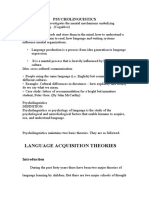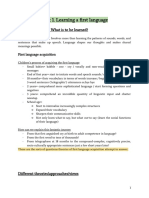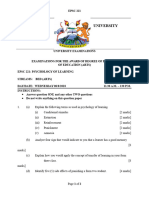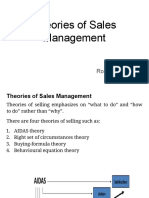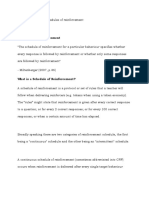0% found this document useful (0 votes)
38 views15 pagesLanguage Learning Theories Notes
The document provides an overview of various theories of language learning, including Behaviorist, Cognitive Code, Creative-Construction Hypothesis, Skill Learning, Interactional, Constructivism, and Socio-Cultural Learning theories. Each theory is defined, along with its proponents, components, strengths, and weaknesses, highlighting the different approaches to understanding how language is acquired and processed. The document emphasizes the complexity of language learning and the interplay between innate abilities, environmental influences, and social interactions.
Uploaded by
boldcoldoldCopyright
© © All Rights Reserved
We take content rights seriously. If you suspect this is your content, claim it here.
Available Formats
Download as DOCX, PDF, TXT or read online on Scribd
0% found this document useful (0 votes)
38 views15 pagesLanguage Learning Theories Notes
The document provides an overview of various theories of language learning, including Behaviorist, Cognitive Code, Creative-Construction Hypothesis, Skill Learning, Interactional, Constructivism, and Socio-Cultural Learning theories. Each theory is defined, along with its proponents, components, strengths, and weaknesses, highlighting the different approaches to understanding how language is acquired and processed. The document emphasizes the complexity of language learning and the interplay between innate abilities, environmental influences, and social interactions.
Uploaded by
boldcoldoldCopyright
© © All Rights Reserved
We take content rights seriously. If you suspect this is your content, claim it here.
Available Formats
Download as DOCX, PDF, TXT or read online on Scribd
/ 15



























